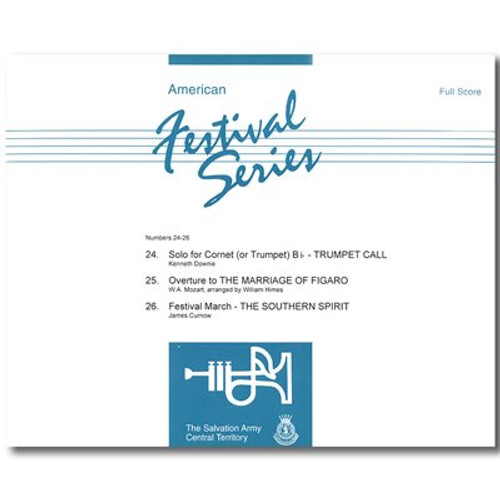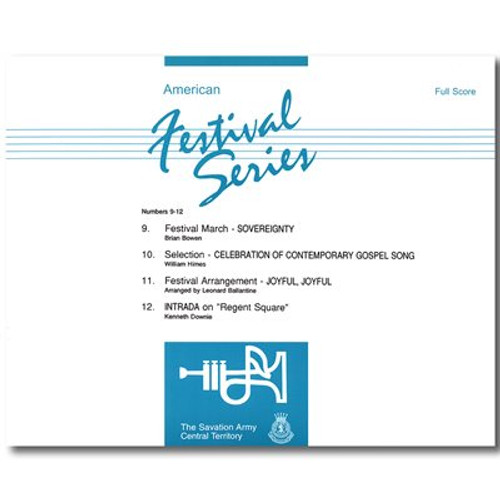Product Description
June 1998 Nos. 20-23
Comments by
Staff Bandmaster William Himes
Music & Gospel Arts Secretary, USA Central Territory
| 20. | Allegro Deciso from The Water Music | G.F. Handel, arr. Gordon Collins | Notes |
| 21. | Selection - Sing Praises | William Gordon | Notes |
| 22. | Solo for Flugel/Trumpet (or Cornet) Bb - Blessed Assurance | Stephen Bulla | Notes |
| 23. | National Anthem - The Star-Spangled Banner | arr. William Himes | Notes |
Produced by The Salvation Army - Central Territory
20. Allegro Deciso from The Water Music
Program Note:
This excerpt from a series of short pieces known as Water Music, was first performed July 1717 in London on the Thames River at a water festivity attended by King George I. This party involved hundreds of boats and barges. As the musicians performed on a barge which traveled with the part, the king was so pleased with what he heard that he requested the music be played at least three times that evening.
This excerpt from a series of short pieces known as Water Music, was first performed July 1717 in London on the Thames River at a water festivity attended by King George I. This party involved hundreds of boats and barges. As the musicians performed on a barge which traveled with the part, the king was so pleased with what he heard that he requested the music be played at least three times that evening.
Note to the Conductor:
In general, one should strive for a refined but festive style, befitting the royal occasion for which these festive themes were written more than two centuries ago. Observe the stately tempo (112) and insist on rhythmic precision throughout. Make sure the melodic phrases always lead to a firm emphasis on beat one. Other specific considerations are detailed as follows:
Bars 11-14: This ff marcato section should be a blended timbre of trombone, baritone and euphonium sounds so as to emulate the noble (and non-vibrato) sonorities of a French horn section.
Bars 15-39: Dynamic contrast is the main objective here. The distinct levels of mf, f, and ff must be firmly established to achieve the appropriate "terrace dynamic style" so typical of Baroque music. This section will be enhanced by the horn, baritone and soprano crescendo in bars 28-31.
Bars 40-65: Much is expected of the soprano, solo and first cornets in this contrasting section. Nevertheless the rolling eight-note (quaver) passages must be light and gentle. (After all, this melodic line was originally orchestrated for violins.)
Give attention to the balance and ensemble of the counter melody in flugel and first baritone. The cornet solo in bars 49-56 should be restrained, with the ornamental trills played with delicate understatement.
The 2nd cornet, flugel, horn, baritone and euphonium sections should work as a team in bars 57-66, executing syncopations with rhythmic precision.
Following the da capo, bars 38-39 should finish with a majestic rallentando.
21. Selection - Sing Praises
Program Note:
This scintillating collection of timeless themes includes "I sing the might power of God," "All creatures of our God and King," "Praise to the Lord, the Almighty," and "Praise God, from whom all blessings flow."
This scintillating collection of timeless themes includes "I sing the might power of God," "All creatures of our God and King," "Praise to the Lord, the Almighty," and "Praise God, from whom all blessings flow."
Note to the Conductor:
The added bonus to this colorful and exciting score is its functionality. The composer offers optional endings so that any of the three sections can be presented separately or as part of a continuous work, thus providing opportunities for use in services and meetings as well as festivals. The structure is as follows:
- 1-106:?? Ellacombe
- 107-161: St.Francis
- 162-end: Lobe den Herren, Old Hundredth
Most of this music is straightforward and relatively easy to anticipate from a rehearsal standpoint. However a few specific comments are offered which may be helpful:
Bars 1-40: The opening section should be vigorous and exciting. Emphasize the accented, syncopated patterns. This will be more easily achieved if the volume of the non-accented notes is understated.
Bars 29-35: Although much is going on here rhythmically, take care that the players do not confuse energy with volume. The dynamic for all (including snare drum) is mp.
Bars 60-63: The syncopated rhythms in the horns and 1st baritone must synchronize with the moving eighths (quavers) in the euphonium and solo horn parts.
Bar 106: As previously mentioned, this bar can serve as an optional ending by ending abruptly with the martellato (��) on beat three, or as a link through the fermata on beat four.
Bars 107-161: With its flowing lines and gentle sonorities, this section would be rightly classified as a pastorale. Let this serve as a lovely contrast to the fire and majesty of the surrounding movements.
Bars 162-206: Note the restrained tempo and strive for a dance-like quality throughout, with a discernable pulse on the straong beats. This is especially necessary for those parts playing the repeated rhythmic ostinato, such as the flugel, solo horn, baritones and euphonium in bar 162. This attention to pulse also applies to the melody (Lobe den Herren) wherever it appears.
Bars 206-207: This is the first of several meter shifts in this piece. The conductor must anticipate these with mathematic precision, in this case shifting from 6/8 to 4/4 with the speed of the eighths (quavers) remaining consistent.
Bars 226-227: The meter shifts back to 6/8 with the same eighth (quaver) equivalent. As in the first instance (206-207), the conductor would do well to practice conducting through the two meters with a metronome clicking the eighth pulse (184 per minute). Eventually calculation will be taken over by a natural feel for the change. (Try not to over-think this or provide complex explanation to the players. If the conductor is confident, the players will usually be able to play it!)
Bars 234-235: Another metrical challenge is presented here- this time with the pulse remaining the same (two beats to the bar). The shift is from 6/8 to 4/4 in alla breve. (Again, the metronome exercise- now set to 92- should help.
Bars 235-262: Given the long sweep of the melody, along with the rhythmic complexity of the background, it is important for the pulse of this section to be felt and conducted in two.
Bars 263-264: This time the metrical shift is accomplished through a molto ritardando (but note the 6/8 tempo arrived at in bar 264 is the same as the previous section!)
Bars 271-272: This section calls for a final shift into 4/4, which is achieved in the same manner as in bars 206-207. What follows is an exciting finish, the key to which is the percussion in the final two bars.
22. Blessed Assurance - Solo for Flugel/Trumpet or Cornet Bb
Program Note:
An inspiring setting of the immortal 19th century gospel song of Fanny Crosby and Mrs. Joseph Knapp, this solo was written for Philip Smith (principal trumpet, New York Philharmonic), who gave its premiere in 1989.
An inspiring setting of the immortal 19th century gospel song of Fanny Crosby and Mrs. Joseph Knapp, this solo was written for Philip Smith (principal trumpet, New York Philharmonic), who gave its premiere in 1989.
Note to the Conductor:
There are few specific technical points to cover in this fine orchestration. Bear in mind that although the andantino is a respectful 58 beats per minute, a lilting 9/8 pulse must be maintained throughout, particularly n the horn/euphonium line.
Bars 1-28: With the flugel featured in the low register, much is demanded of the accompaniment in terms of control and finesse. There is much going on in the accompaniment- but all of it must be unobtrusive. (Note the "second time only" indications in the cornets and trombones.)
Bars 30-36: Although the flugel plays in the higher register in this slightly quicker (poco piu mosso) section, the solo can easily be overpowered by the accompaniment. One solution is to have the melody (solo/1st cornets) "pull away" intensity when landing on the long tones of hte melody in bars 31, 33 and 35.
Bars 36-47: This section represents the only true "band break" in the piece. Therefore the band should take the lead while the soloist changes instruments from flugel to trumpet (or cornet). The change of meter (but not tempo) in bar 42 is easily achieved if most of the attention is given to the syncopated accompaniment in the trombones and basses. The ritardando at bar 46 should be dramatic, with the timpani roll in the follow bar having all the flair of an Academy Awards announcement!
Bars 47-55: The soloist now enters on trumpet to an accompaniment style that is punctuated and brilliant.
Bars 56-66: Quickly reduce the intensity in this contrasting section. The carillon effect in the cornets (second time only) will require careful rehearsal to achieve an effect that is precise, yet glossy.
Bars 67-end: The full band accompaniment is in a marcato style, yet must not be so heavy as to cause the soloist to overwork while playing up in the stratosphere. Strive for a finish that is dramatic and inspiring.
23. The Star-Spangled Banner
Note to the Conductor:
While it would be futile to attempt ot outdo Erik Leidz��n's classic setting of the American national anthem published forty years ago in the American Band Journal (USA Eastern Territory, New York), it was felt that a new arrangement with the expanded scoring format of the Festival Series could provide added usefulness and interest to this patriotic melody.
In fact the approach to this setting could best be described as "text painting," wherein the mood of the music mirrors the feelings of the text. Hence, the stormy (and optional) introduction quickly gives way to the tentative uncertainty of the opening lines, which pose questions in the aftermath of battle. (Roughly paraphrased, "Can you see how it ended? Did we win? Is our flag still there?")
Memories of the fierce conflict are recounted and portrayed in the middle section ("And the rockets' red glare, the bombs bursting in air..") symbolized with soaring runs coming up from the basses through cornets, followed by the accented motifs of combat.
At the risk of stating the obvious, inspire of all the musical fireworks, the tune must be at the fore throughout.








